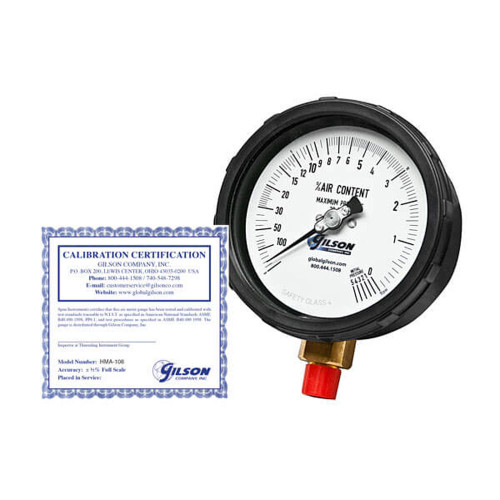Fast
Shipping
Quick,
Simple Ordering
Clear,
Upfront Pricing
Over 30,000
Happy Customers
Exceptional
Customer Service
Industry's Largest
Catalog
Concrete Air Meter Gorilla Gauge, Calibration Certificate
The Concrete Air Meter Gauge is a tough, accurate and long lasting upgrade for most Type B Concrete Air Meters. Features not found on lower quality gauges are a wide profile phosphor bronze Bourdon tube and a rugged precision mechanism for dependable accuracy. Fine calibration adjustments and screws on the dial face are micro adjustable for easy “tweaks” during calibration, saves time and makes calibration and maintenance easier. Accuracy is ±1/2% of full scale. The calibration vessel is a must have for accurate air content measurements during calibration.
The Concrete Air Meter Gauge 3-1/2in (89mm) dial face is a tough, accurate and long lasting gauge. Features over other styles are a wide profile phosphor bronze Bourdon tube and a German engineered precision mechanism for dependable accuracy. Fine screws on the dial face are micro adjustable for easy tweaks during calibration, saves time and makes calibration and maintenance easier. The Gorilla Gauge is ANSI rated B40 Grade 2A with accuracy to ±1/2% of full scale. An air pump is used with the air meter to measure air voids in fresh concrete, for accurate air content readings.
Polymid B housing is high strength, waterproof, rustproof and impact resistant. O-ring gasket on the threaded bezel is a seal against moisture and dust. Dual layer safety glass lens is scratch and break resistant and replaceable. 1/4in NPT brass threads fit most concrete air meters.
What is Concrete Air Entrainment?
Concrete air entrainment is the process of introducing air bubbles into the concrete mixture to improve durability and freeze thaw resistance. This is done by using entrained air admixtures which create small entrained air voids in the concrete mixture. These air voids act as tiny reservoirs for freezing water, preventing damage and relieving internal pressure meter. Air entrainment in the concrete mix is critical for quality and longevity of the concrete, making it more resistant to harsh environmental conditions.
Why Use Concrete Air Meters
Concrete air meters are essential for measuring air content in fresh concrete. The benefits are:
-
Quality and durability of concrete
-
Freeze thaw protection
-
Risk of concrete failure
-
Meets ASTM and AASHTO air content testing standards
By measuring the volume of entrained air bubbles in fresh concrete, concrete air meters determine the quality and durability of the concrete and meets the standards and performs well in all applications.
How Entrained Air Meters Work
Air entrainment meters work by measuring the pressure meter change in a sealed container filled with fresh concrete. The container has a pressure gauge that measures the pressure meter change as the air bubbles in the concrete expand and contract. This pressure change is directly related to the air content in the concrete. By measuring this pressure change, air entrainment meters can determine the air content in the concrete, for quality and performance.
Concrete Air Meter Gauge Specifications
Polymid B housing is high strength, waterproof, rustproof and impact resistant. Threaded bezel has O-ring gasket, seals the gauge from moisture and dust. Dual layer safety glass lens is scratch and break resistant and replaceable. Overall gauge size is 4-1/4 x 2in (108x51mm) Dia. x H, 3-1/2in (89mm) dial face. 1/4in NPT brass threads fit most concrete air meters.
Concrete Air Meter Gauge Test Methods for Air Content
Meets:
Aggregate Correction Factor
The aggregate correction factor is a key parameter in concrete air entrainment testing. It adjusts the air content measurement for the effect of aggregate on the air bubbles in the concrete. Different aggregates affect the air bubbles differently; some absorb more air than others and can impact the accuracy of the air content measurement. By applying the aggregate correction factor, air entrainment meters can give a more accurate air content measurement for reliable results.
Concrete Properties Affected by Air Entrainment
Air entrainment affects:
-
Workability: Air entrainment improves workability by reducing the viscosity of the concrete, making it easier to mix and place.
-
Strength: While air entrainment reduces the strength of the concrete by creating air voids that are weak points, the trade off is often worth it for the added durability.
-
Durability: Air entrainment increases the durability of the concrete by reducing the freeze thaw damage, more resistant in harsh climates.
-
Permeability: Air entrainment can affect the permeability of the concrete by creating air voids that allow water to enter, which can be good or bad depending on the application.
In general air entrainment can be good or bad for concrete properties depending on the application and amount of air entrained. Knowing this is key to optimizing concrete mixes for your construction needs.







